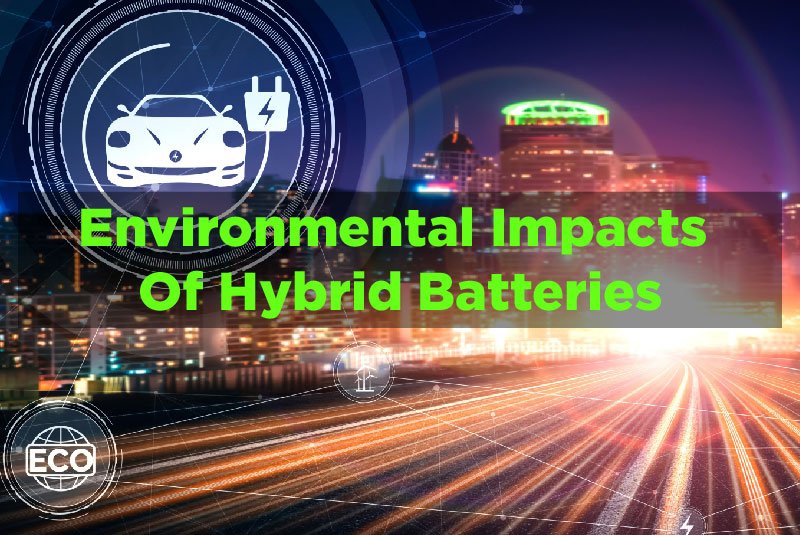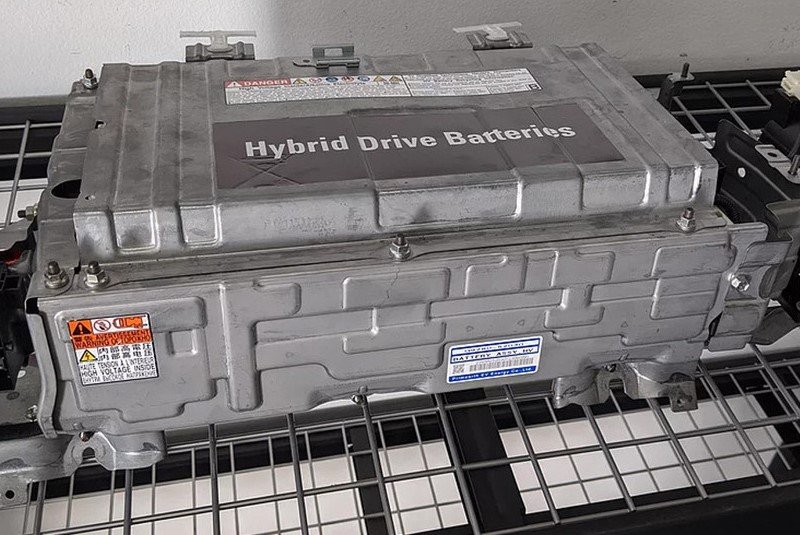Environmental Impacts Of Hybrid Batteries: Are Batteries Bad for the Environment?
As we move towards greener technologies, hybrids are the middle ground between gas guzzlers and fully electric cars. With a combination of a gasoline engine and an electric battery, hybrids get better fuel economy and lower emissions. However, hidden beneath their eco-friendly promise is the often-overlooked environmental impact of hybrid car batteries. How green are they really?
What are hybrid car batteries, and how do they work?
Hybrids use either nickel-metal hydride (NiMH) or lithium-ion batteries to store energy from braking and convert it into electric power, reducing fuel consumption and emissions. Despite their efficiency, battery production, use and disposal have environmental challenges. Production of an average lithium-ion battery has a big carbon footprint, using three times more cumulative energy than traditional batteries. So, what’s the overall cost to the environment?
The Hybrid Battery Environmental Cost
Hybrid car batteries require vast resources, particularly the mining of metals like nickel, cobalt and lithium. These extraction processes lead to deforestation, habitat destruction and water pollution, and the battery manufacturing process generates significant greenhouse gas emissions. Although hybrids reduce tailpipe emissions, the environmental cost starts before the car hits the road.
Recycling: The Solution to the Problem
Hybrid batteries can be recycled, which conserves resources and minimises environmental harm. However, recycling processes are still evolving, and many batteries end up in landfills, leaking hazardous chemicals into the environment. As hybrid car numbers grow, we need more efficient recycling systems to recover valuable materials like lithium and nickel. Lead acid batteries are highly recyclable, with 99% of the materials recoverable, much better than lithium-ion batteries.
Aloy Hybrid Battery Service: Reconditioning for Sustainability
Aloy Hybrid Battery Service takes the battery environmental impact seriously by reconditioning. Here’s how we address the challenges and reduce the footprint:
Extend Battery Life to Reduce Waste
Reconditioning hybrid batteries extends their life, reducing electronic waste. Instead of discarding old batteries, we restore them for continued use, keeping harmful materials out of landfills and ecosystems.
Conserve Raw Materials
Battery production requires mining, but reconditioning saves valuable resources like lithium, cobalt and nickel. By choosing reconditioned batteries, you reduce the need for new materials and the environmental impact of mining.
Reduce Energy Consumption and Emissions
Reconditioning is much less energy-intensive than manufacturing new batteries. By choosing reconditioned batteries, you conserve energy, reduce overall carbon emissions, and help the car industry become cleaner.
Encourage Sustainable Behaviour
At Aloy Hybrid Battery Service, we promote sustainability by allowing consumers to choose refurbished batteries. Our service helps change consumer behaviour to more eco-friendly options and sustainability in the car industry.
Support Recycling and Responsible Disposal
By reconditioning hybrid batteries, we promote proper recycling. Our commitment is that when batteries reach the end of life, they are recycled responsibly, and environmental harm is minimised.
A Greener Future with Reconditioned Hybrid Batteries
Hybrid batteries are both an opportunity and a challenge for sustainable transport. They reduce emissions, but production and disposal are environmentally concerned. Aloy Hybrid Battery Service bridges the gap by reconditioning hybrid batteries, reducing electronic waste, conserving natural resources and reducing carbon emissions. Together, we can make sure hybrid cars are a step towards sustainability and not a big footprint.
What are Hybrid Car Batteries, and How do Lithium Ion Batteries work?
Hybrid battery production, especially lithium-ion batteries, requires energy-intensive mining of materials like nickel, cobalt and lithium. These processes lead to deforestation, pollution and significant greenhouse gas emissions and add to their environmental footprint. Electric vehicles require more lithium-ion battery mining, which has a big impact on the environment through byproducts and energy-intensive processes.
Environmental Impact of Hybrid Batteries Production
Lithium-ion battery production has a big environmental impact mainly due to the extraction and processing of raw materials like lithium, cobalt and nickel. Mining of these materials can lead to soil degradation, water pollution and loss of biodiversity. The production process itself requires a lot of energy, which is often generated by fossil fuels and adds to greenhouse gas emissions.
The environmental impact of battery production can be broken down into:
Raw Material Extraction: Extraction of lithium, cobalt and nickel requires energy and water and leads to environmental degradation and water pollution. Mining often results in deforestation, destruction of natural habitats and loss of biodiversity.
Processing and Manufacturing: Processing and manufacturing of battery cells and packs are energy-intensive processes. Fossil fuels often generate energy and add to significant greenhouse gas emissions. This stage of battery production adds a big chunk to the overall carbon footprint of lithium-ion batteries.
Transportation: Transportation of raw materials and finished batteries also requires energy and adds to greenhouse gas emissions. The global battery production supply chain involves a lot of shipping and logistics and adds to the environmental cost.
To reduce the environmental impact of battery production, manufacturers are looking at:
Renewable Energy: Using renewable energy like solar and wind to generate the energy needed for production can reduce the carbon footprint of battery manufacturing.
Recycling: Implementing recycling programs to recover materials from spent batteries can conserve resources and reduce the need for new raw material extraction.
Sustainable Sourcing: Sourcing raw materials from suppliers that follow sustainable and responsible mining practices can reduce environmental degradation and promote ethical practices in the supply chain.
Battery Recycling and Sustainability Challenges
Battery recycling is a key to reducing the environmental impact of lithium-ion batteries. Recycling can recover materials, reduce waste and conserve natural resources. But lithium-ion battery recycling is still in its infancy, and there are several challenges to be addressed:
Lack of Infrastructure: The absence of dedicated recycling facilities and infrastructure hinders the wide adoption of battery recycling. Many regions lack the necessary systems to collect and process spent batteries efficiently.
High Costs: Recycling of lithium-ion batteries is more expensive than producing new batteries and is not economically viable for many manufacturers. This economic barrier slows down the development and implementation of recycling programs.
Technical Challenges: The complexity of lithium-ion battery chemistry and design makes it difficult to develop efficient and cost-effective recycling technologies. The variety of battery types and compositions adds to the challenge of creating standardised recycling processes.
To overcome these challenges, researchers and manufacturers are looking at new recycling technologies and strategies:
Mechanical Recycling: Using mechanical processes to break down batteries and recover materials. This involves physically disassembling batteries to separate and reclaim lithium, cobalt and nickel.
Hydrometallurgical Recycling: Using chemical reactions to dissolve and recover materials from spent batteries. This can extract metals and other valuable elements and make them available for use in new batteries.
Closed-Loop Recycling: Designing recycling systems that can recover and reuse materials from spent batteries and reduce the need for primary production. Closed-loop systems aim to create a circular economy for battery materials and reduce waste and environmental impact.
The Lithium Battery Paradox
Lithium-ion batteries are key to the low-carbon economy, enabling the widespread adoption of electric vehicles and renewable energy systems. However, the production of lithium-ion batteries has big environmental impacts, mainly due to the extraction and processing of raw materials.
This paradox means we need a more sustainable approach to battery production, one that balances the benefits of lithium-ion batteries with the environmental costs. Manufacturers, policymakers and consumers must work together:
Increase Recycling Rates: Recycling of lithium-ion batteries is key to recovering materials and reduce waste. Better recycling programs can conserve resources and reduce the environmental footprint of battery use.
Sustainable Sourcing: Sourcing raw materials from suppliers that follow sustainable and responsible mining practices can reduce the environmental impact of battery production. Ethical sourcing can improve environmental and social outcomes in mining regions.
Invest in Renewable Energy: Switching to renewable energy to power production can reduce greenhouse gas emissions from battery manufacturing. Using solar, wind and other renewable energy sources can create a more sustainable production process.
By addressing the environmental impact of hybrid batteries production, we can create a sustainable future for the low-carbon economy. Balancing the benefits of electric vehicles and renewable energy systems with responsible production practices is key to long-term sustainability.
FAQs
Are batteries bad for the environment?
Batteries can be bad for the environment, especially during production, use and disposal. The mining of raw materials like lithium and cobalt and the energy-intensive manufacturing process create pollution and greenhouse gas emissions. However, recycling batteries and developing sustainable technologies can reduce the impact.
How do lithium-ion batteries affect the environment?
Compared to fossil fuel vehicle batteries, hybrid car batteries (lithium-ion) produce more emissions during production and are a big environmental problem when not disposed of properly.
How do electric vehicles affect the environment?
Electric vehicles with lithium-ion batteries reduce fossil fuel use, reduce greenhouse gas emissions and improve air quality. However, the environmental impact of producing and recycling electric vehicle batteries is a problem.
Can rechargeable batteries be recycled?
Yes, rechargeable batteries like lithium-ion can be recycled. Recycling lithium batteries is important because they create big waste problems at the end of life, with only a small percentage being recycled. The process conserves raw materials and reduces environmental harm, but it is tricky and dangerous if not done properly. Current recycling technologies need to be improved for efficiency and cost.
What’s the carbon footprint of lithium-ion batteries?
The carbon footprint of lithium-ion batteries is based on the energy-intensive production process, including mining and refining of raw materials. However, using them in electric vehicles reduces emissions over time compared to fossil fuel cars.
What happens when lithium-ion batteries reach the end of life?
When lithium-ion batteries reach the end of life, they must be recycled properly to avoid environmental harm. Improper disposal can create hazardous waste, cause landfill fires, and release toxic chemicals.
How does battery production affect the environment?
Battery production, especially for lithium-ion and electric vehicle batteries, is energy-intensive and can harm the environment. Mining of lithium, cobalt and other raw materials also creates pollution, deforestation and water pollution.
What are the environmental impacts of lithium mining?
Lithium mining has several environmental impacts, including water pollution, soil degradation and destruction of ecosystems. The extraction process requires a large amount of water and can have harmful effects on local communities and wildlife.
How does battery recycling reduce environmental harm?
Recycling batteries reduces the need for new raw materials, conserves resources and prevents hazardous substances from getting into the environment. Efficient recycling is key to reducing the environmental footprint of battery use.
What’s the role of solid-state batteries in reducing environmental impact?
Solid-state batteries are a developing technology that can provide higher energy density with fewer environmental downsides. They can reduce the use of hazardous materials and be safer than traditional lithium-ion batteries.
How can reusing batteries reduce environmental impact?
Reusing or reconditioning batteries extends their life and reduces new battery production and overall environmental burden. Conserve resources and reduce e-waste.
What are the environmental risks of landfill fires from batteries?
Batteries in landfills can leak toxic chemicals and catch fire, releasing harmful fumes into the air. Proper recycling and disposal are key to avoiding these risks.



